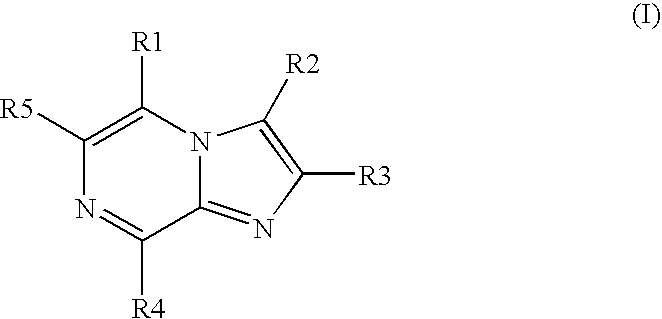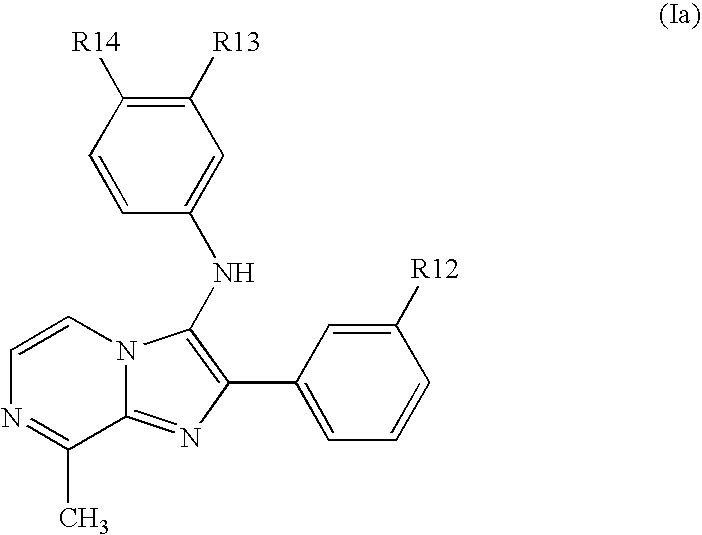Protein kinase inhibitors
a protein kinase and inhibitor technology, applied in the field of angiogenesis inhibitors, can solve the problems of malignant transformation, increase the incidence of receptor dimerization, aberrant and uncontrolled cell proliferation and tumour formation, etc., and achieve the effect of blocking receptor autophosphorylation and activation
- Summary
- Abstract
- Description
- Claims
- Application Information
AI Technical Summary
Benefits of technology
Problems solved by technology
Method used
Image
Examples
example 1
(3-Chloro-phenyl)-(8-methyl-2-phenyl-imidazo[1,2-a]pyrazin-3-yl)-amine (3)
[0080] (General Method A)
[0081] 3-Methyl-pyrazin-2-ylamine (2) (109 mg, 1.0 mmol), benzaldehyde (106 mg, 1.0 mmol) and 3-chloro-phenylisonitrile (138 mg, 1.0 mmol) were dissolved in a mixture of dry methanol (2.0 mL) and trimethyl orthoformate (2.0 mL) under argon. The mixture was stirred at 60° C. for 3 hours, then cooled to rt. An analytically pure sample of 3 was obtained from the crude product using preparative HPLC.
example 2
(3,4-Dichloro-phenyl)-(2-phenyl-imidazo[1,2-a]pyrazin-3-yl)-amine (29)
[0082]
[0083] (General Method B)
[0084] 2-Amino-pyrazine (95 mg, 1.0 mmol) and benzaldehyde (106 mg, 1.0 mmol) were dissolved in dry dioxane (2.0 mL) containing molecular sieves (3A) under argon. After 5 minutes sulfuric acid (20 μL) and 3,4-dichloro-phenylisonitrile (172 mg, 1.0 mmol) were added. The mixture was then stirred at 50° C. for 3 hours, cooled to rt and filtered. The product 29 was obtained by crystallization from acetonitrile.
example 3
N′8-Benzyl-N′3-(3-chloro-phenyl)-2-phenyl-imidazo[1,2-alpyrazine-3,8-diamine (22)
[0085]
[0086] (General Method C for Aminosubstituted Derivatives)
[0087] 2-Amino-3-chloro-pyrazine (130 mg, 1.0 mmol) and benzaldehyde (106 mg, 1.0 mmol) were dissolved in dry dioxane (3.0 mL) containing molecular sieves (3 Å) under Argon. After 5 minutes sulfuric acid (20 μL) and 3-chlorophenylisonitrile (138 mg, 1.0 mmol) were added. The mixture was then stirred at 50° C. for 3 hours, cooled to rt and filtered.
[0088] Benzylamine (536 mg, 5.0 mmol) was added to the filtrate and the mixture was heated to 60° C. for 20 h. After cooling to rt, filtration and evaporation to dryness, an analytically pure sample of 22 was obtained from the crude product using preparative HPLC.
PUM
| Property | Measurement | Unit |
|---|---|---|
| Fraction | aaaaa | aaaaa |
| Fraction | aaaaa | aaaaa |
| Length | aaaaa | aaaaa |
Abstract
Description
Claims
Application Information
 Login to View More
Login to View More - R&D
- Intellectual Property
- Life Sciences
- Materials
- Tech Scout
- Unparalleled Data Quality
- Higher Quality Content
- 60% Fewer Hallucinations
Browse by: Latest US Patents, China's latest patents, Technical Efficacy Thesaurus, Application Domain, Technology Topic, Popular Technical Reports.
© 2025 PatSnap. All rights reserved.Legal|Privacy policy|Modern Slavery Act Transparency Statement|Sitemap|About US| Contact US: help@patsnap.com



